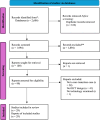A systematic review of the impacts of remote patient monitoring (RPM) interventions on safety, adherence, quality-of-life and cost-related outcomes
- PMID: 39025937
- PMCID: PMC11258279
- DOI: 10.1038/s41746-024-01182-w
A systematic review of the impacts of remote patient monitoring (RPM) interventions on safety, adherence, quality-of-life and cost-related outcomes
Abstract
Due to rapid technological advancements, remote patient monitoring (RPM) technology has gained traction in recent years. While the effects of specific RPM interventions are known, few published reviews examine RPM in the context of care transitions from an inpatient hospital setting to a home environment. In this systematic review, we addressed this gap by examining the impacts of RPM interventions on patient safety, adherence, clinical and quality of life outcomes and cost-related outcomes during care transition from inpatient care to a home setting. We searched five academic databases (PubMed, CINAHL, PsycINFO, Embase and SCOPUS), screened 2606 articles, and included 29 studies from 16 countries. These studies examined seven types of RPM interventions (communication tools, computer-based systems, smartphone applications, web portals, augmented clinical devices with monitoring capabilities, wearables and standard clinical tools for intermittent monitoring). RPM interventions demonstrated positive outcomes in patient safety and adherence. RPM interventions also improved patients' mobility and functional statuses, but the impact on other clinical and quality-of-life measures, such as physical and mental health symptoms, remains inconclusive. In terms of cost-related outcomes, there was a clear downward trend in the risks of hospital admission/readmission, length of stay, number of outpatient visits and non-hospitalisation costs. Future research should explore whether incorporating intervention components with a strong human element alongside the deployment of technology enhances the effectiveness of RPM. The review highlights the need for more economic evaluations and implementation studies that shed light on the facilitators and barriers to adopting RPM interventions in different care settings.
© 2024. The Author(s).
Conflict of interest statement
The authors declare no competing interests.
Figures


References
-
- Condry MW, Quan XI. Remote patient monitoring technologies and markets. IEEE Eng. Manag. Rev. 2023;51:59–64. doi: 10.1109/EMR.2023.3285688. - DOI
-
- Fortune Business Insights Research. Remote Patient Monitoring Devices Market Size, Share & Covid-19 Impact Analysis, by Type (Devices{Multi-Parameter Monitoring, Respiratory Monitoring, Blood Glucose Monitoring, Cardiac Monitoring, and Others} and Services), by Application (Oncology, Diabetes, Cardiovascular Diseases, and Others), by End-User (Payers, Providers and Patients), and Regional Forecast, 2021-2028. FBIR. https://www.fortunebusinessinsights.com/remote-patient-monitoring-device.... Published 2023. Accessed 12.06.2024.
-
- Hood C., Neal S., Manaoat Van, C. & Mossburg, S. E. Remote Patient Monitoring. AHRQ. https://psnet.ahrq.gov/perspective/remote-patient-monitoring. Published 2023. Accessed 12.06.2024.
-
- Shaik T, et al. Remote patient monitoring using artificial intelligence: current state, applications, and challenges. WIREs Data Min. Knowl. Discov. 2023;13:e1485. doi: 10.1002/widm.1485. - DOI
-
- Babar ETR, Rahman MU. A smart, low cost, wearable technology for remote patient monitoring. IEEE Sens. J. 2021;21:21947–21955. doi: 10.1109/JSEN.2021.3101146. - DOI
Publication types
LinkOut - more resources
Full Text Sources
Miscellaneous

